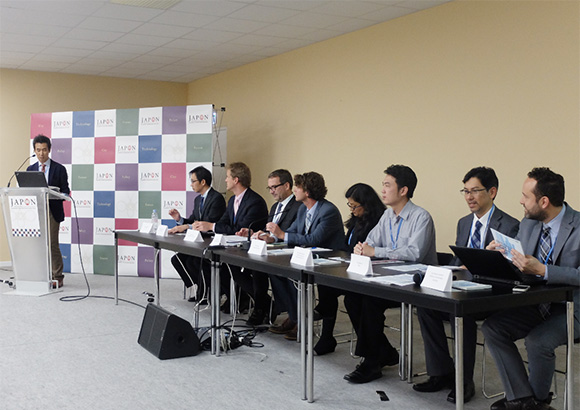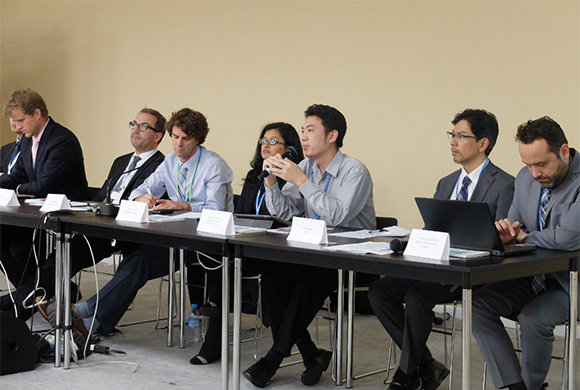Tools for the Promotion of Low Carbon Societies: MRV and NAMA Guidebooks
Overseas Environmental Cooperation Center, Japan (OECC); Institute for Global Environmental Strategies (IGES)
Outline
The event will serve to introduce the MRV Guidebook and the NAMA Guidebook, as well as other initiatives used as tools to support practitioners in the promotion of low carbon societies and capacity building activities.
Program
-
- Opening Remarks
- Jiro Ogahara, Overseas Environmental Cooperation Center (Japan)
-
- Introduction of the NAMA Guidebook
- Jiro Ogahara, Overseas Environmental Cooperation Center (Japan)
-
- Introduction of the MRV Guidebook
- Kazuhisa Koakutsu, Institute for Global Environmental Strategies (Japan)
-
- Introduction of tools for NAMAs and MRV
- John Oliver Niles – GHG Management Institute (USA)
Christian Dannecker – South Pole Group (Switzerland)
-
- Panel discussion
-
- [Discussants]
- John Oliver Niles – GHG Management Institute (USA)
Christian Dannecker – South Pole Group (Switzerland)
Martin Frick – Food and Agriculture Organization of the United Nations (Italia)
Ritika Tewari – NewClimate Institute (Germany)
Wee Keang Fong – World Resources Institute (China office)
Thawachai Somnam – Thailand Greenhouse Gas Management Organization (Thailand)
Jose Manuel Sandoval – Ministry of Environment (Colombia)
Jiro Ogahara, Overseas Environmental Cooperation Center (Japan)
- [Moderator]
- Kazuhisa Koakutsu, Institute for Global Environmental Strategies (Japan)
Summary
Opening Remarks
Mr. Jiro Ogahara, Senior Researcher, the Overseas Environmental Cooperation Center, Japan (OECC), welcomed the panelists and explained the purpose and structure of the side event.
Presentations
Mr. Jiro Ogahara (OECC) presented the recently published 3rd edition of the NAMA Guidebook. He explained the relations with the previous guidebooks, and presented the outcomes obtained such as usage of the guidebook in capacity building activities and distribution in specific networks.
Mr. Kazuhisa Koakutsu (IGES), introduced the MRV Guidebook written in collaboration with researchers of international organizations such as Mr. Wee Kean Fong (WRI), and explained the importance of these tools for the implementation of mitigation actions.
Mr. John Niles (GHG Management Institute), introduced a variety of courses related to mitigation and MRV that they have developed. They are currently developing academic partnerships across countries and courses in countries.
Mr. Christian Dannecker (South Pole Group), introduced MRV and monitoring and evaluation (M&E) for NAMAs, and clarified what “transformational” really means. Their contribution to the NAMA Guidebook focuses in MRV and M&E systems that cover some gaps identified and helps to achieve and quantify sustainable development goals. He also referred to the NAMA Sustainable Development Tool developed for UNDP among others.
Panel Discussion
Provided general directions for actions post-Paris, based on information provided by countries such as national communications and now INDCs. In order to do that, he presented some key questions and also one table showing characteristics of each of the tools introduced by the panelists.
Martin Frick (FAO) talked about the learning tool they have developed for mitigation in agriculture with a focus on linkages for mitigation and adaptation, which ultimately is related to improvement of agriculture and food security.
Mr. Wee Keang Fong (WRI), complemented with and explanation of the GHG Protocol for Cities they have developed. He emphasized on the importance of partnerships between supporting organizations. He observed that transparency is important but too much focus on measurement is not conducive to actions necessarily.
Ms. Ritika Tewari (NewClimate Institute), did not present a specific tool, however she mentioned her organization’s work on assessing the missed benefits of countries’ national contributions and quantification of potential co-benefits.
The moderator passed to ask the representatives from developing countries to provide opinions on the tools described before.
Mr. Thawachai Somnam (TGO), referred that the NAMA Guidebook has been useful not only for policy making, but also for the practitioner on the ground, since NAMAs in Thailand are developed through the bottom-up approach.
Mr. Jose Manuel Sandoval (Ministry of Environment, Colombia), indicated that currently Colombia has 15 NAMAs and they have developed a whole MRV strategy which is linked to their low-carbon strategy. This is focused in three main areas: 1) being able to track progress on mitigation actions, 2) inventories due to reporting responsibilities have changed with the introduction of BURs, 3) model to track national and international climate finance.
As a conclusion, Mr. Frick (FAO) underlined the importance of INDCs in the sense that it represent a commitment to actions. Every country is now taking responsibility of those actions, which means, partnerships will become even more important and will allow to put all stakeholders in the same table.
Christian Dannecker (SPG) indicated that there are many different requirements in NAMAs, BURs, and INDCs and hence some sort of standardized MRV can facilitate the process.
The Panel ended with a comparison of each of the tools through a matrix. It has been concluded that many of these tools have similarities and the potential for replication in different countries, and that forms of distribution can be improved.
Key Messages
- Many organizations have developed different tools for NAMAs and MRV, in an independent, rather than coordinated manner.
- Practitioners from developing countries require information, capacity building, and guidance from supporting organizations. In that sense, tools are useful and are welcome.
- Since financing will always be a requirement, it is necessary to think in interventions in a more coordinated manner among supporting organizations, with a focus on implementation of the transformational aspect.
Photograph
Reporters
Jiro Ogahara, Senior Researcher, Overseas Environmental Cooperation Center, Japan (OECC)






